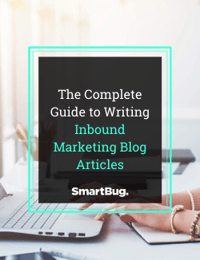.jpg?%20Increase%20Low%20Conversion%20Rates%20On%20Your%20Blog%20(1).jpg&width=1180&name=061621_%20How%20to%20Lower%20High%20Bounce%20Rates%20%26%20Increase%20Low%20Conversion%20Rates%20On%20Your%20Blog%20(1).jpg?%20Increase%20Low%20Conversion%20Rates%20On%20Your%20Blog%20(1).jpg)
How to Lower Bounce Rates and Increase Conversion Rates for Your Blog
July 2, 2021
By Tyler Smith
Congratulations! Your organization is already producing blog articles on a consistent basis. Chances are that you know the benefits of blogging and the impact it can have on your organization’s website traffic growth over time. But what if the benefits stop there, and website traffic is all your site is gaining from your diligent writing efforts? When traffic bounces from each blog post without exploring the rest of your website, you may start to wonder if your time would be better spent on other marketing tactics.
I’m here to encourage you not to give up! High blog post bounce rates and low blog-generated conversions are indicators of issues that are preventing your blog from soaring in traffic. Simple tweaks might be all you need to get your blog over the hump to becoming a key traffic and lead driver.
Here’s what you need to do if your blog has a high bounce rate and is struggling to generate conversions.
Step 1: Reassess Your Keyword Strategy
For your blogging efforts to make an impact on your website traffic, you need to have a quality keyword strategy. Building this strategy involves sourcing keywords that are relevant to your brand, indicate that users are in the market for your solution, and have a low difficulty score.
When users bounce, it’s often because the problem or interest they searched for in Google doesn’t match the solution or topic presented in your blog post. That often happens when there’s keyword misalignment. Misalignment can happen if your keyword targeting is too broad (you’re targeting the keyword “dogs” when you should be targeting “dog-walking services”) or maybe there are multiple meanings to the keywords you’re targeting.
For example, the term “managed IT services” often has a different meaning than “IT services,” with the latter more focused on software and product development and the former associated with your standard IT department tech support—two very different offerings. If you were to make the first page in Google search engine results page (SERP) for IT services despite being a managed service provider, a large amount of the traffic coming to your blog would be unqualified, which leads to a high bounce rate.
Google the terms you’re targeting and see what kind of results come up. Do the top results reflect your offerings? Do you see competitors or organizations from other industries in the top results?
You want to make sure that there’s limited variation on the user's intent when they are entering the keyword into the search bar.
Step 2: Ensure Posts Provide Value to Buyer Personas
You know your audience best. What are their goals? What are their greatest challenges? What about their role stresses them out?
Your blog posts should be solving these questions.
It’s not always easy to produce this type of content. It may be appealing to write about an industry news story or a new product rollout, but unless your content is providing value to the reader, they aren’t going to stick around and read through it.
If you’re struggling to brainstorm topics, take some time to interview your best customers. Ask them what type of content they like to read, what their daily struggles are, and how your company’s solution is making their lives easier and build content around those interviews. If you aren't comfortable with asking your clients to interview, you can send out surveys to your contact pool asking what type of content and subjects they’d like to see.
When your company’s blog posts are helping to solve the real issues your prospects experience, you’ll start to see better engagement and a declining bounce rate for your blog.
Step 3: Add CTAs to All Blog Posts
Now that qualified, engaged traffic is starting to flow through your blog posts, how do you turn that traffic into conversions?
Calls to action (CTAs) represent the best opportunity to convert blog traffic into contacts and, in turn, leads. You should include clear CTAs on each blog post you produce—one mid-post and one at the end, both directing back to the same conversion opportunity on your website.
For example, if your company has an upcoming webinar, you should be creating graphic CTAs to register for the webinar and placing those on posts that have a similar subject to the webinar. This gives users who are already engaged with high-value content another opportunity to engage with additional helpful content in exchange for contact information.
To get the largest share of your blog traffic clicking on CTAs, you should be testing the following:
- Different CTA versions: To uncover what types of messages are most impactful for your audience
- Smart CTAs: To provide specific content offers to users based on their buyer persona and lifecycle stage
- Pop-up forms: To offer another blog page conversion opportunity—this type of CTA should also be promoting relevant, high-value content
See what type of CTAs work best for your audience, and use that strategy to build CTAs for every conversion opportunity you have on your website.
A Quick Win and Some Big Conversion Rate Gains
One of the quickest conversion rate optimization wins you can have on your blog is creating a blog subscription. Users are already engaged with your company’s posts, so creating an option to receive updates when new posts go live will provide an easy way to generate contacts via your blog. Even easier, if you’re a HubSpot user, these emails are auto-generated and require little time commitment, beyond setting up the initial email template and look.
When each of your posts are optimized with relevant, high-volume keywords and compelling CTAs, and they provide clear value to your audience, you’ll start seeing your blog’s conversion rate trend in the right direction.

About the author
Tyler Smith was formerly an Inbound Marketing Strategist at SmartBug Media. He recognizes how critical an established content process is to the successful growth of any company's online presence and lead generation. Tyler excels in using the digital and inbound marketing methods that make sense for each unique business to grow their customer base. Read more articles by Tyler Smith.









